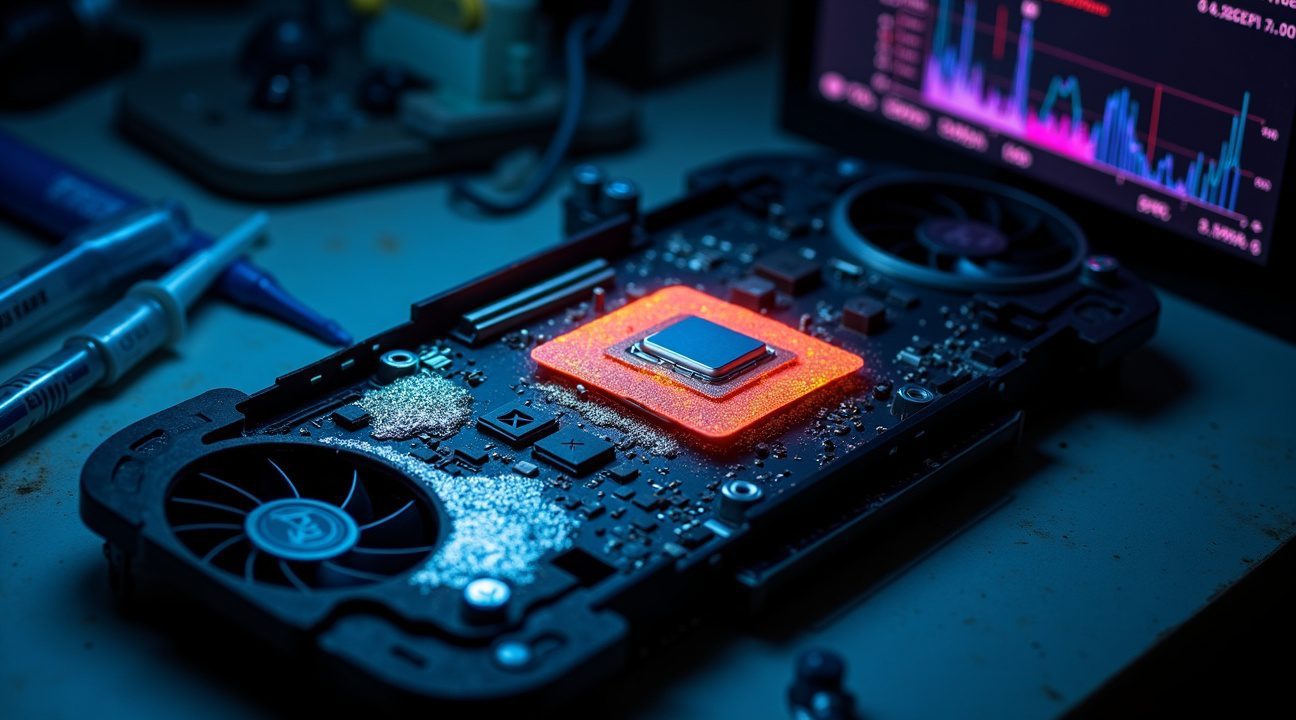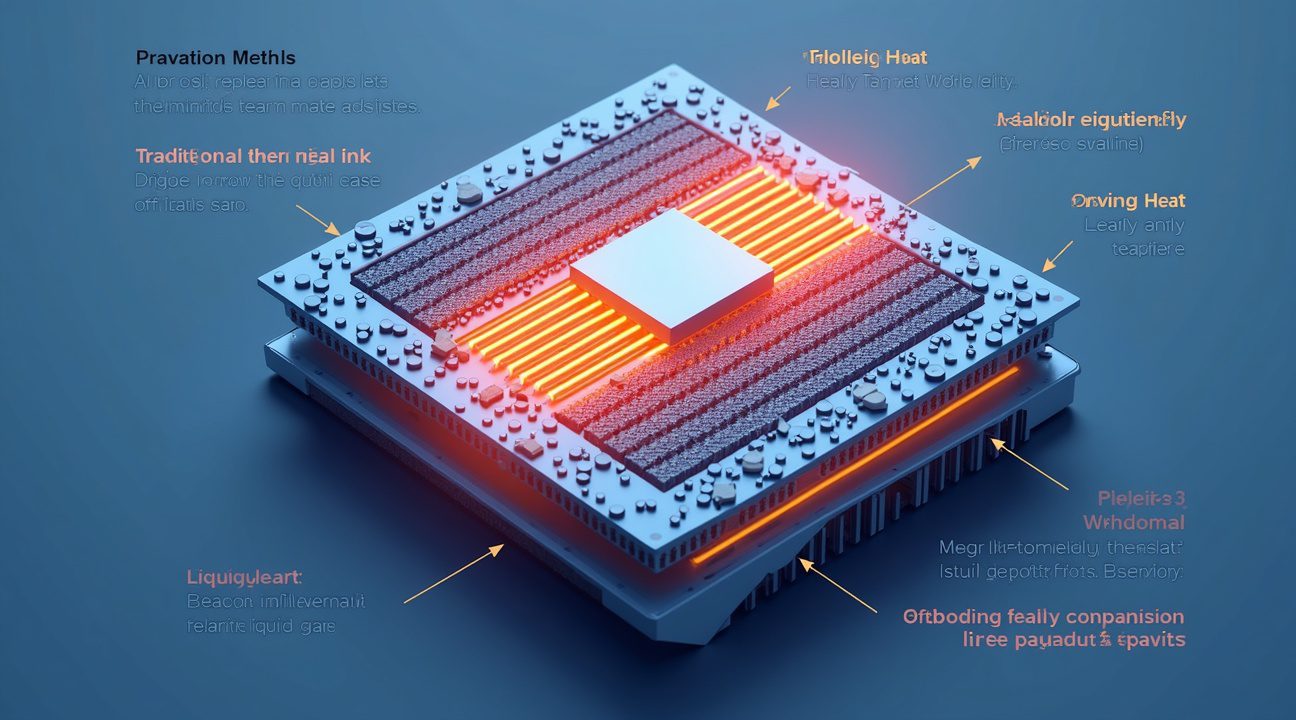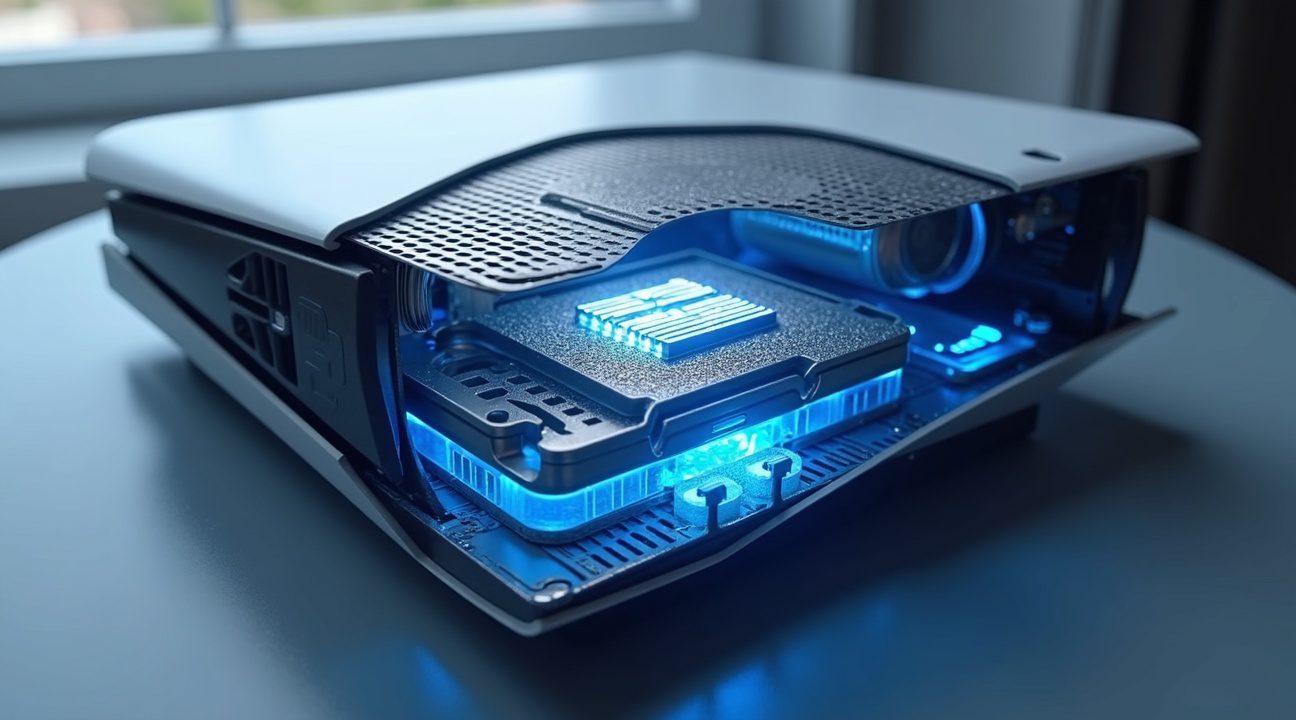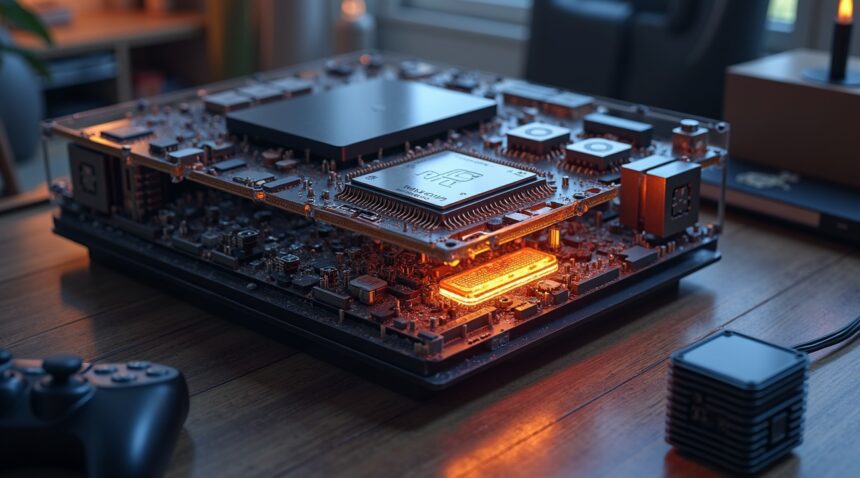PS5 liquid metal thermal solutions frequently develop problems within 3-5 years of standard use, with issues appearing even earlier for heavy gamers due to intense usage and accelerated wear.
Key Takeaways
- PS5 liquid metal degradation typically occurs between 3-5 years for casual users, but heavy gaming reduces this lifespan to just 2-3 years.
- Common warning signs include louder fan noise, random shutdowns during intense games, reduced system performance, and higher temperature readings.
- Sony addressed these issues in the PS5 Pro by introducing grooved cooling assemblies aimed at preventing thermal solution migration.
- Horizontal console orientation is proven to extend the thermal compound’s longevity by allowing gravity to assist in keeping the liquid metal in place.
- Routine professional maintenance every 3-5 years can significantly reduce the risk of critical hardware failure, whereas do-it-yourself repairs may lead to permanent damage.
For more technical insights, users can explore resources and updates available through Sony’s official support site: PlayStation Support.
PS5 Consoles Face Critical Cooling Failures Within 3–5 Years
The PlayStation 5’s liquid metal thermal solution isn’t as permanent as many users expect. Repair specialists and teardown experts have documented concerning patterns showing liquid metal degradation occurring between 3 to 5 years of normal use, with some units experiencing problems much sooner.
Timeline of Liquid Metal Degradation
Dry spots represent the most common failure mode, developing when liquid metal coverage becomes insufficient across the processor surface. Oxidation compounds this issue, particularly in consoles operating under high-heat conditions or inadequate ventilation. User reports consistently point to failures emerging within 2–3 years for heavy gaming sessions, often coinciding suspiciously with warranty expiration periods.
Liquid metal migration creates another serious concern. The material can shift away from critical contact points, pooling in areas where it provides no thermal benefit. This redistribution severely impairs heat transfer capabilities, forcing internal components to operate at dangerous temperatures that trigger protective shutdowns.
Warning Signs of Cooling System Failure
Console owners should monitor several key symptoms that indicate liquid metal deterioration:
- Fans running louder and more frequently during gameplay
- Sudden shutdowns during graphically intensive games or extended sessions
- Higher processor temperatures measured through system monitoring
- Performance drops or frame rate issues in previously stable games
- Random crashes during demanding titles that previously ran smoothly
Heavy gamers who enjoy taxing titles for hours report these symptoms most frequently. Extended gaming sessions place continuous thermal stress on the cooling system, accelerating liquid metal breakdown. Performance anomalies often appear first during graphics-heavy games before affecting general system operation.
The timing of these failures raises questions about PlayStation 5 pricing strategies and long-term support. Many users discover cooling problems just after their warranty expires, leaving them responsible for expensive repairs or replacement costs.
Environmental factors significantly influence failure timelines. Consoles in dusty environments, enclosed entertainment centers, or rooms with poor airflow develop problems faster than units in optimal conditions. Regular cleaning and proper ventilation can extend liquid metal lifespan, but won’t prevent eventual degradation.
Professional repair technicians report increasing numbers of PS5 units requiring liquid metal reapplication or complete thermal solution replacement. These repairs require specialized equipment and expertise, making DIY fixes impractical for most users. Early recognition of cooling problems allows owners to address issues before permanent hardware damage occurs.

Why Sony’s Liquid Metal Design Creates Both Benefits and Risks
Sony engineered the PS5 with liquid metal alloy technology that pushes thermal management to new levels. The company chose Galinstan—a combination of gallium, indium, and tin—as the thermal interface material between the APU and heatsink. This decision delivers exceptional thermal conductivity at 73 W/mK, dramatically outperforming traditional thermal paste, which typically achieves only 8-9 W/mK.
I see this choice as both innovative and calculated, addressing the PS5’s need to manage substantial heat output from its custom AMD processor. The liquid metal spreads more effectively than conventional alternatives, filling microscopic gaps and creating superior heat transfer pathways. Heat dissipation becomes significantly more efficient, allowing the console to maintain optimal performance during demanding gaming sessions.
However, this advanced cooling solution introduces unique failure modes that traditional thermal paste doesn’t present. The liquid characteristics that make Galinstan effective also create potential vulnerabilities that can develop after years of use.
Understanding the Primary Risk Factors
Several specific failure mechanisms can compromise the liquid metal system over time:
- Drying: The liquid metal loses its fluid properties and begins to solidify or become less malleable, reducing the material’s ability to maintain proper contact between surfaces and decreasing thermal transfer efficiency.
- Migration: The liquid metal can flow away from its intended application area. Gravity, temperature fluctuations, and vibrations may cause the material to shift, leading to uneven heat distribution and potential overheating in underserviced areas.
- Pooling: Accumulation of liquid metal in one location creates hot spots where insufficient cooling occurs and other regions experience unnecessary buildup. This results in uneven thermal management and may cause thermal throttling or even system shutdowns.
- Leakage: Escaped liquid metal may make contact with other electronic components. Since Galinstan conducts electricity, unintended contact can trigger electrical shorts and potentially cause permanent damage to the console’s circuitry.
Console orientation significantly influences these risk factors. Horizontal placement supports proper liquid metal distribution by aligning with gravitational forces. This reduces stress on the interface layer and helps keep the material evenly spread.
In contrast, vertical positioning presents additional challenges. Gravity continuously pulls the liquid downward, which can lead to pooling at the bottom and inadequate contact at the top of the processor over time. As a result, the system may lose thermal efficiency and experience increased failure risks.
User reports increasingly document failures linked to liquid metal issues, particularly dry spots that develop after extended use. These failures often manifest as sudden overheating, unexpected shutdowns, or permanent system damage. The recurrence of these problems suggests that degradation follows predictable patterns related to time and environmental conditions.
Temperature cycling exacerbates degradation. Repeated heating and cooling alter both the properties and placement of the liquid metal. Each cycle destabilizes the material further, making it more prone to migration or drying. Sony’s recent price adjustments reflect ongoing hardware refinements aimed at addressing these thermal management challenges.
The liquid metal system’s complexity means that minor changes in material behavior can evolve into significant cooling problems. Unlike traditional thermal paste, which ages predictably, liquid metal may suffer sudden failure modes that endanger overall system integrity. As such, continued monitoring and preventive measures are critical to sustaining long-term console reliability.
https://www.youtube.com/watch?v=eWJA1WnrM3I

Liquid Metal Proves 24% More Effective Than Traditional Cooling
Controlled testing reveals the substantial performance advantage of Sony’s liquid metal implementation in PS5 consoles. When stress-tested with fans disabled, PS5 systems using liquid metal survived 16 minutes and 29 seconds before overheating, compared to just 13 minutes and 12 seconds for traditional thermal paste alternatives. This 24% improvement demonstrates why Sony’s cooling strategy represents such a significant advancement over previous generations.
The superior heat transfer capabilities of liquid metal create multiple benefits beyond raw thermal performance. Users experience notably quieter operation during intensive gaming sessions, as the efficient heat dissipation reduces the need for aggressive fan curves. System throttling decreases significantly during high-load scenarios, allowing the PS5 to maintain peak performance for extended periods without thermal limitations compromising gameplay experience.
Migration Risks and Maintenance Considerations
Despite its effectiveness, liquid metal cooling presents unique challenges that traditional thermal solutions don’t face. Material migration becomes a concern over time, particularly if the console experiences frequent movement or temperature cycling. When the liquid metal shifts from its optimal position, cooling efficiency drops dramatically, potentially leading to system instability or component damage.
Some enthusiasts have experimented with replacing the factory liquid metal with conventional thermal paste, reporting functional systems for up to two years. However, these modifications come with significant trade-offs:
- Reduced cooling efficiency compared to the original design
- Increased fan noise during demanding games
- Higher likelihood of thermal throttling
- Potential warranty voiding
Sony explicitly discourages such modifications due to the engineered thermal requirements of the PS5’s high-performance components. The console’s design specifically accounts for liquid metal’s superior thermal conductivity, meaning alternative cooling solutions may struggle to handle the system’s heat output adequately.
Regular maintenance becomes crucial for preserving liquid metal’s effectiveness. Dust accumulation around cooling components can impede airflow, forcing the liquid metal to work harder and potentially accelerating degradation. Professional servicing every 18-24 months helps ensure optimal performance, though most users will experience reliable cooling for several years with proper care and moderate usage patterns.
Sony Acknowledges Problems with PS5 Pro Design Updates
Sony’s response to thermal management concerns became evident with the PS5 Pro’s launch in 2025. The company introduced fine grooves in the cooling assembly specifically to address liquid metal stability issues that plagued early PS5 units. These grooves work to contain and distribute the thermal interface material more effectively, preventing the migration problems that caused performance degradation in previous models.
Engineering teardowns reveal Sony’s commitment to extending the thermal solution’s lifespan. The manufacturer states these design improvements target multiple years of reliable operation without user intervention. However, the very existence of these modifications serves as an indirect acknowledgment that the original PS5 design had shortcomings.
Design Evolution Reflects User Experience
The transition from the original PS5 to the Pro model tells a revealing story. Sony’s decision to modify the cooling assembly wasn’t made in isolation—it came as a direct response to user reports of premature thermal failures. Early alarms about liquid metal degradation prompted these engineering changes, though Sony never explicitly admitted fault with the original design.
I’ve observed that Sony’s hardware decisions often reflect broader market pressures. The company faced growing concerns about long-term reliability, particularly as users began reporting thermal throttling and system instability after 2-3 years of use. These reports coincided with warranty expiration periods, creating additional consumer frustration.
Current Recommendations Despite Improvements
Even with the PS5 Pro’s enhanced design, Sony continues to recommend specific best practices for optimal thermal performance. The following guidelines remain crucial for maximizing liquid metal longevity:
- Maintain horizontal console placement to prevent gravitational effects on thermal material
- Ensure adequate ventilation around the console’s intake and exhaust ports
- Perform periodic cleaning of external vents to prevent dust accumulation
- Monitor system temperatures during extended gaming sessions
- Avoid frequent console movement or transportation
The contrast between original PS5 and PS5 Pro models becomes stark when examining official documentation. Sony now openly discusses potential migration and leakage as recognized failure points in their support materials. This represents a significant shift from the original launch messaging, which positioned liquid metal as a permanent, maintenance-free solution.
Manufacturing statements about the Pro model emphasize durability improvements while carefully avoiding direct criticism of the predecessor. The grooved cooling assembly represents more than a simple upgrade—it’s an admission that the original approach had fundamental flaws. Users who experienced early failures with standard PS5 units can view the Pro’s modifications as validation of their concerns.
The engineering changes also suggest Sony learned valuable lessons from real-world usage patterns. Laboratory testing couldn’t replicate the diverse environmental conditions and usage scenarios that revealed liquid metal’s limitations. Temperature fluctuations, humidity variations, and different gaming habits all contributed to premature failures that the initial design didn’t account for.
Despite these improvements, the fundamental physics of liquid metal thermal interfaces remain unchanged. The material still exhibits temperature-dependent viscosity and can migrate under specific conditions. Sony’s grooved design reduces these risks but doesn’t eliminate them entirely. Users should understand that even with enhanced stability, the thermal solution isn’t truly permanent.
The PS5 Pro’s design updates reflect a more mature understanding of liquid metal behavior in consumer electronics. Sony’s hardware strategy now acknowledges the need for containment mechanisms and user education about proper handling. This evolution demonstrates how consumer feedback can drive meaningful engineering improvements, even when companies initially resist acknowledging design shortcomings.
Current estimates suggest the PS5 Pro’s thermal system should maintain effectiveness for 4-5 years under normal usage conditions. This represents a significant improvement over original PS5 units, where issues often surfaced within 2-3 years. However, these projections assume proper care and environmental conditions, making user adherence to best practices more important than ever.

Essential Maintenance Steps to Prevent Catastrophic Console Failure
Regular monitoring represents your first line of defense against liquid metal degradation in the PS5. I recommend conducting periodic inspections every 3–5 years to catch potential issues before they escalate into catastrophic hardware failures.
The console’s orientation significantly impacts liquid metal longevity. Horizontal positioning provides the simplest method to reduce migration risks, as gravity works with the thermal design rather than against it. While vertical orientation won’t immediately damage your system, I discourage extended use in this position unless space constraints make it absolutely necessary.
Critical Warning Signs That Demand Immediate Attention
Several specific symptoms signal potential liquid metal issues that require prompt professional intervention:
- Fans running louder than normal during standard gaming sessions
- Excessively hot air exhausting from the console vents
- Unexpected system shutdowns during demanding gameplay
- Performance instability or frame rate drops in previously smooth games
- Console feeling unusually warm to the touch during light usage
Sony’s latest hardware revisions include design improvements that address some thermal concerns, but vigilance remains essential. The PS5 Pro features enhanced grooves that help retain liquid metal in its intended position for extended periods, though this doesn’t eliminate the need for long-term monitoring.
If any overheating symptoms, performance instability, or unexpected shutdowns occur, consulting a repair specialist familiar with PS5 liquid metal maintenance becomes critical. These issues can escalate rapidly, potentially damaging expensive components like the APU or surrounding circuitry.
Professional service provides the safest approach for liquid metal replacement or system evaluation. The technical complexity of accessing the PS5’s cooling system requires specialized tools and expertise that most users lack. Attempting DIY repairs risks voiding your warranty and potentially causing irreversible damage to delicate components.
Temperature monitoring through the console’s built-in diagnostics can provide early warning signs of thermal issues. Games that previously ran silently shouldn’t suddenly trigger aggressive fan speeds, and any deviation from normal thermal behavior warrants investigation.
The investment in professional maintenance every few years costs significantly less than replacing a damaged console. Sony’s service policies continue evolving, making authorized repair services increasingly accessible for thermal system maintenance.
Consistent horizontal orientation, combined with adequate ventilation and periodic professional inspection, maximizes your PS5’s operational lifespan while minimizing the risk of liquid metal-related failures.

Sources:
TweakTown, “PS5 with liquid metal lasts 24% longer in heat test than thermal paste”
Player.One, “Sony Revamps Cooling System in PS5 Pro to Boost Stability and Longevity”
TronicsFix.com, “PS5 Liquid Metal Dry Spots and Replacement”
TweakTown, “PlayStation 5 liquid metal problems can kill the console in just a matter of years, with more and more users reporting problems over time”
ComputersPlus.co.uk, “PS5 Liquid Metal Leaks – How to Keep your Console Safe”
YouTube: MASSIVE PS5 / PLAYSTATION 5 WARNING! CONSOLES…
YouTube: PS5 with Thermal Paste STILL WORKS after 2 years! By:NSC
iFixit, “Liquid metal oxidation, and prevention. How often should it be redone”


